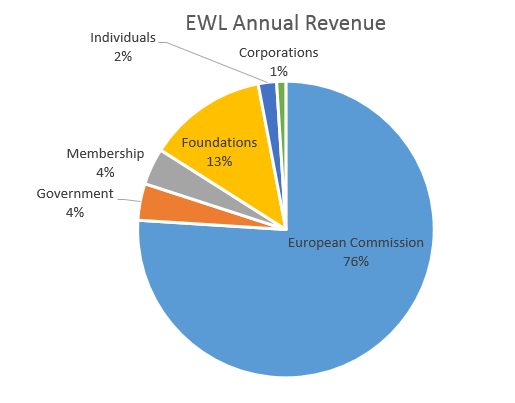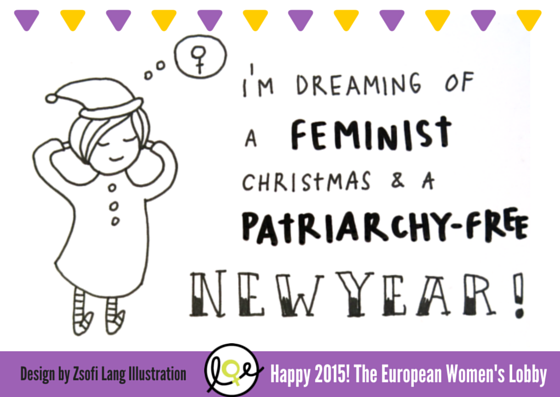[Brussels, 03 June 2013] From the European Commission – Early this week the Commission released a report on the Barcelona objectives concluding Member States must do more for childcare and published a new expert study on the gender gap in pensions in the EU.
The EWL welcomes the report and study that highlights the relationship between care and inequality. Gender inequality persists as care continues to be framed as a women’s issue, rather than a collective societal responsibility. The gender pension gap mirrors the accumulation of all the gender inequalities that women face across their life-cycle.
The current 16 percent pay gap paves the way for the resulting pension pay gap of 39 percent in Europe. In Germany, for example, women receive pensions 60 percent lower than that of men’s- a fast track to poverty and a desperate cry for individualized taxation and social security – a vital step to becoming independent citizens and humans. EWL calls for benchmarks and targets, impact assessments, gender mainstreaming and solidarity across the EU on issues affecting not only half the population but society as a whole.
Childcare: Commission calls on Member States to do more
Member States will need to step up their efforts to improve childcare provisions if the EU is to reach its 75% employment rate target by 2020, said the European Commission in a report released today. The progress report finds that just eight countries have met both targets agreed at EU level for availability and accessibility of childcare services (see Annex). The so-called ‘Barcelona targets’, agreed by EU leaders in 2002, say that childcare should be provided for 90% of children between three years old and the mandatory school age, and for 33% of children under three. Meanwhile, a new study also released by the Commission today sheds light on the phenomenon of the ‘gender pension gap’, showing that on average across the EU, women’s pensions are 39% lower than men’s.
“Every parent knows only too well how crucial affordable and accessible childcare is not only for the development of the child but also for working parents. Yet, so far, fewer than 1 in 3 Member States has managed to reach their own childcare targets,” said Vice-President Viviane Reding, the EU’s Commissioner for Justice, Fundamental Rights & Citizenship. “Member States have to buckle down if they want to reach the 75% employment goal they have signed up to. Childcare provision should not be seen as a cost, but as an investment in tomorrow.”
Figures for 2010 show that most EU countries have missed their own targets for childcare provision: only eight were able to meet the targets for both age categories (0-3 years; 3 years to mandatory school age): Belgium, Denmark, Spain, France, the Netherlands, Sweden, Slovenia and the United Kingdom. Only 10 Member States reached the first category target (0-3 years) and 11 the second category target (3 years to mandatory school age) (see Annex).
Meanwhile, data just released for 2011 show a fall in the provision of childcare for older children, meaning some countries that reached the target in 2010 now fall behind the threshold of 90% (Spain, the Netherlands and Ireland).
Policies for better work-life balance – in particular childcare services – are key to promoting women’s employment. More women working is essential to reaching the EU’s employment targets and improving overall economic strategy. That is why on 29 May, the Commission proposed country-specific recommendations to the Council under the third European Semester for 2013 (see IP/13/463). Recommendations have been addressed to 11 Member States1 on female employment, on childcare availability/quality and/or full-day school places and on care services.
New Study on the Gender Gap in Pensions
Today the Commission also published a new expert study on the gender gap in pensions in Europe – the first study of its kind. The study reveals that the effects of lower employment rates among women extend into their retirement age: women receive average pensions which are 39% lower compared to those of men. Gender gaps in pensions are the result of three labour market trends: (1) women are less likely to be in employment than men; (2) they work fewer hours and/or years; and (3) they receive lower wages on average. Pension systems are not simply neutral reflections of past employment histories: pensions may reduce, reproduce or even reinforce gender inequalities in the labour market and in the division of care responsibilities between women and men.
A new indicator for gender equality, the “Gender Pension Gap”, helps to assess the magnitude of gender inequality in the course of people’s lives. The situation across the EU is very diverse (see Annex). Wide gender pension gaps are found in a large number of Member States: 17 have pension gaps greater or equal to 30%. The two widest gender pension gaps are found in Luxembourg (47%) and Germany (44%). At the other extreme, Estonia has the lowest gender pension gap (4%), followed by Slovakia (8%).
Marriage and motherhood are found to increase gender pension gaps. Gaps are narrower for single women, though they remain large (17%). Data also show a clear ‘motherhood penalty’: having children leads to pension disadvantages for women in nearly all Member States. In most cases, the ‘children penalty’ increases with the number of children (see Annex).
Background
In 2002, Head of State and Government of EU countries, agreed in the conclusions of the European Council in Barcelona that:
“Member States should remove disincentives to female labour force participation and strive, taking into account the demand for childcare facilities and in line with national patterns of provision, to provide childcare by 2010 to at least 90% of children between 3 years old and the mandatory school age and at least 33% of children under 3 years of age.”
Since then, these have been known as the “Barcelona targets” for childcare facilities and their achievement has been at the core of policies to reconcile work, private and family life at EU and the Member States level.
Childcare facilities have also been a priority in the Commission’s strategies on gender equality, while EU financial support has been provided under the Structural Funds (in particular the European Social Fund).
Although some progress has been made since 2002 and despite the Member States’ commitments, the EU childcare supply in 2010 does not yet comply with these targets.
For more information
- EU Childcare report:
http://ec.europa.eu/justice/gender-equality/files/documents/130531_barcelona_en.pdf
- Study on the Gender Gap in Pensions:
http://ec.europa.eu/justice/gender-equality/files/documents/130530_pensions_en.pdf
- European Commission – Gender equality:
http://ec.europa.eu/justice/gender-equality/index_en.htm
- Homepage of Vice-President Viviane Reding, EU Justice Commissioner:
http://ec.europa.eu/reding
- Follow the Vice-President on Twitter: @VivianeRedingEU


